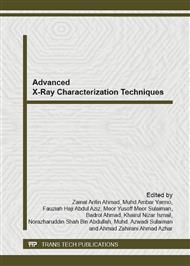p.66
p.72
p.77
p.82
p.87
p.94
p.99
p.105
p.112
Properties of Mortar Containing Rice Husk Ash at Different Temperature and Exposed to Aggressive Environment
Abstract:
The properties of mortar containing rice husk ash at varying temperatures were studied. Three rice husk ash samples were prepared at different temperatures and with various colors, i.e., 600°C (pink), 800°C (grey), and 1000°C (white), all were used for this study. Ordinary Portland cement (OPC), a well known universal binder, was partially replaced with rice husk ash at 10, 15, 20, and 30% by weight of binder. The water to binder ratio (W/B) of the mortar was kept constant at 0.45. The mortars were subjected to seawater or saturated Ca (OH)2 solution. The controlled and exposed mortars were characterized using X-ray diffraction, FTIR spectroscopy and compressive strength test. The results show that the amount of silica present in RHA are varied with burning temperature and colors, approximately in the range of 95 to 97%. White RHA produced higher compressive strength both in seawater and Ca (OH)2 solution. Finally, white RHA with 15% replacement was most suitable to be used as additive in OPC, and showed good potential for use in seawater applications and alkaline environment.
Info:
Periodical:
Pages:
87-93
Citation:
Online since:
December 2012
Keywords:
Price:
Сopyright:
© 2013 Trans Tech Publications Ltd. All Rights Reserved
Share:
Citation:


